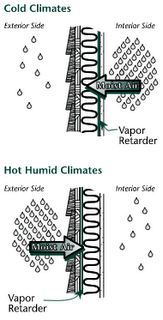Vapor Retarders:
A vapor retarder (barrier) is defined by ASTM C 755 as a material that has a water vapor permeance (perm) rating of one (1) or less. The terms vapor retarder and vapor barrier are used interchangeably and describe the same materials. For consistency, the term retarder will be used here.
What Does A Vapor Retarder Do?:
Occupants of buildings, appliances, and plumbing equipment generate moisture that is carried in the air as a vapor. As moisture vapor moves from a warmer interior through construction materials to a cooler surface, the moisture may condense as water, which may damage the building. It is for this reason that vapor retarders, which retard the flow of moisture through construction materials, are installed in buildings. By locating vapor retarders as close as possible to the warm-in-winter (heated interior) surface of the building, the moisture vapor flow is restricted before it has a chance to condense to water.
Vapor Retarder-Faced Insulations:
The vapor retarder facing should be installed toward the warm-in-winter side of the construction except where noted. This means that in ceilings the vapor retarder faces down, in walls it faces the inside, and in floors over unheated spaces it faces up. With the exception of reverse-flange insulation, the stapling flanges are on the same side as the vapor retarder. In warm, humid climates local practice should be followed regarding the use of and/or placement of vapor retarders.
Note: The ASHRAE Handbook of Fundamentals, Chapter 23, Thermal and Moisture Control in Insulated Assembly Application, contains information on the placement and use of vapor retarders in various climates including humid climates such as Florida, the Gulf Coast, or Hawaii.
When Is A Vapor Retarder Required?
Good construction practice calls for installing vapor retarders in walls of all new buildings. Local building codes should be followed with regard to the need for vapor retarders in ceilings. When it is convenient to do so, vapor retarders should be installed in existing buildings. In some cases local building codes may conflict with common building practices regarding the use of vapor retarders. Always confer with local building departments before beginning construction.
Cautions!
Always follow these rules when working with vapor retarder-faced insulation:
Many facings are flammable. Because of this, when vapor retarders face building spaces intended for human use, they must be covered. These spaces include garages, storage rooms, utility rooms and laundries. NAIMA recommends that this statement be printed on all combustible facings:
"This vapor retarder is flammable and should not be left exposed. Special care should be taken when working close to the facing with an open flame."
(For exposed applications, insulations with special, strong, reinforced flame resistant facings are available.)
Batt and blanket insulations may be installed one on top of the other in ceilings where there is adequate space. Only the bottom layer should have a vapor retarder, which should face down toward the space that is warm-in-winter. Additional layers should be unfaced. If unfaced insulation is not available, use the faced type but remove the facing completely before installation.
Repair damaged vapor retarders. Rips or tears in the vapor retarder facing may be repaired by covering the damaged area with scrap vapor retarder material and taping it in place or, in the case of small rips, by using duct tape or polyvinyl tape. Gaps around windows, doors and other openings should be covered with vapor retarder facing or taped.
Avoid electrical wiring when stapling vapor retarders or facings. Care should be taken not to staple into electrical wiring when installing faced batts and blankets or separate vapor retarders.
Other Vapor Retarder Materials:
The use of separate vapor retarders with unfaced insulation is becoming more common. They should face the warm-in-winter side of the framing. Four-mil, or thicker, polyethylene sheeting, available in rolls, is rolled out horizontally and stapled to the face of the framing, at top, bottom and the side. If one sheet of poly is not wide enough to cover the area and a second sheet of polyethylene is required, they should be overlapped on the stud space where they meet and stapled to adjoining studs.
Foil-backed gypsum board is also an effective vapor retarder. Other options for providing a vapor retarder include gypsum board manufactured with a vapor retarder or vapor retarder type paint, which may be used in renovations.


No comments:
Post a Comment